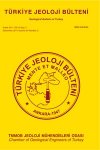
-
2024
-
2023
-
2022
-
2021
-
2020
-
2019
-
2018
-
2017
-
2016
-
2015
-
2014
-
2013
-
2012
- 2011
-
2010
-
2009
-
2008
-
2007
-
2006
-
2005
-
2004
-
2003
-
2002
-
2001
-
2000
-
1999
-
1998
-
1997
-
1996
-
1995
-
1994
-
1993
-
1992
-
1991
-
1990
-
1989
-
1988
-
1987
-
1986
-
1985
-
1984
-
1983
-
1982
-
1981
-
1980
-
1979
-
1978
-
1977
-
1976
-
1975
-
1974
-
1973
-
1972
-
1971
-
1970
-
1969
-
1968
-
1966
-
1964
-
1963
-
1961
-
1959
-
1958
-
1955
-
1954
-
1953
-
1952
-
1951
-
1950
-
1949
-
1948
-
1947
Abstract: In central Anatolia which was known as a quiescent region in terms of earthquake in general, somedevastated earthquakes have occured in several places of the region in the past. One of these earthquakesis the April 19, 1938 Akpinar (Kırşehir) earthquake (Ms 6.8) which occured on the Akpınar segmentlocated in northwest of the NW-SE trended Seyfe Fault Zone in the east of Kırşehir. After April 19, 1938earthquake, by using the data of the geological and geophysical studies done in the region, a Coulombstress model of the earthquake on the Seyfe Fault Zone has been obtained. The stress increase causedby the earthquake ranges between 0.137-4.5 bar. This has increased the seismic hazards around theresidential areas around the Seyfe Fault Zone such as Keskin (Kırıkkale) and Boztepe (Kırşehir) regions.
Abstract: It is presented here some unusual brecciated rock clasts within the clastic deposits of the Late Mioceneand Pliocene at the Mucur (Kırşehir) area of central Anatolia, Turkey. Petrographycally, these clasts aredescribed as tachylite or impactite. They are dark-coloured metamorphic rock fragments with size of 100to 3-4 cm in diameter, which are abundantly breccaited and to a lesser extend melted-rock fragmentsembedded in thick silica layers. The tachylite clasts are found only at the lower and medial part of the LateNeogene sequence, forming only 1-1.5 % of the total clast components of the host deposits. These specialclasts (tachylite or impactite) represent the destroyed walls of an impact crater created by an asteroid atcentral Anatolia in pre- Late Miocene time. Based on tachylite types and their abundance, the inferredimpact crater was a circular depression with minimum 200 m depth and 2 km in diameter. The possiblepalaeogeographic and palaeoecological results of such a big impact to the earth have been searched.
Abstract: Kastamonu city center falls in the first degree earthquake zone in the latest map of 1996 which is still inforce. 46 percent of the surface area of Kastamonu province is in the first degree hazard zone, 22 percentin the second degree hazard zone, 24 percent in the third degree hazard zone and 8 percent in the fourthdegree hazard zone. Although the city center is located the first degree hazard zone, there are very fewstudies on seismicity and seismic hazard for this region. The seismicity of Kastamonu has been investigated by using the earthquakes with a magnitude of 4.0 greater that occurred in a region with a 150-km radius for the time interval 1900-2011. Epicentersof earthquakes were relocated to make a correlation with the active faults and to determine the seismicactivity in the region. The earthquakes are particularly concentrated on the active tectonic lines such asthe North Anatolian Fault Zone, the Dodurga fault, the Eldivan Elmadağ tektonic junction, the Merzifonfault and the Taşova Çorum fault zone. The aim of this study is to predict probability of earthquake occurrences and return periods for Kastamonuand near surroundings by using the earthquakes with a magnitude of 4.0 greater (M >=4.0) thatoccurred in regions with 50, 100 and 150 km radius for the time interval 1900 2011. Hence a statisticalaspect based on Poisson model and a classical linear magnitude-frequency relation of Gutenberg-Richterwere used for each region. The earthquake occurrence probabilities for investigated area were calculated for some periods of T =10, 20, 30, 40, 50, 75, 100 years and for magnitudes of M = 5.0, 5.5, 6.0, 6.5, 7.0, 7.5. Within a radius 150km of Kastamonu city center, the occurrence probability and recurrence period of an earthquake with amagnitude of 7.5 greater in 100 years were calculated as 75 percent.
Abstract: Chalcedony, quartz and amethyst vein and veinlets which are emplaced in the cracks and fractures ofparticularly in basaltic andesites around Belkavak village of Yerköy- Yozgat are investigated. Fluid inclusionstudies carried out on in solutions rich in silica for determination of the formation temperatures and theorigins of the salinities. Siliceous veins cut the Middle Eocen basaltic andesites. During the studies, fivedifferent silica zones were distinguished respectively consisting of chalcedony, white quartz, transparentquartz-I, amethyst and transparent quartz-II. Homogenization temperatures and % NaCl equivalentsalinty parameters are dedected. First stage consists of chalcedony bands. Their cryptocrystalline texture have led to no fluid inclusions. The white quartz crystalls are formed after chalcedony bands and theirhomogenization temperatures measured as between 272 and 323°C, salinities between 3.86 and 4.65% NaCl equivalent. During transparent quartz-I formation stage corresponding temperatures weredetermined as ranging between 217 and 280°C and salinities between 3.06 and 4.96 % NaCl equivalent.During the formation of amethyst crystals, homogenization temperatures changing from 162 to 370°Cand salinities of 1.73 to 4.96 % NaCl equivalent are measured. At the the final stage, transparent quartzII crystals are formed. Their homogenization temperatures varied between 120 to 270°C and salinitiesbetween 0 to 6.88 % NaCl equivalent.According to the obtained data, previously ascending siliceous solutions emplaced in the open spaces ofcracks and fractures in a relatively cold environment and hence the formation of chalcedony occurred.Then, the temperatures of the ascending siliceous solutions reached up to 200-370°C and graduallydecreased to 120 °C. Generally, rates of salinity is below %8, therefore it can be postulated that meteoricwater was in interaction with seawater during the formations of quartz and amethyst crystals.

 TMMOB
TMMOB